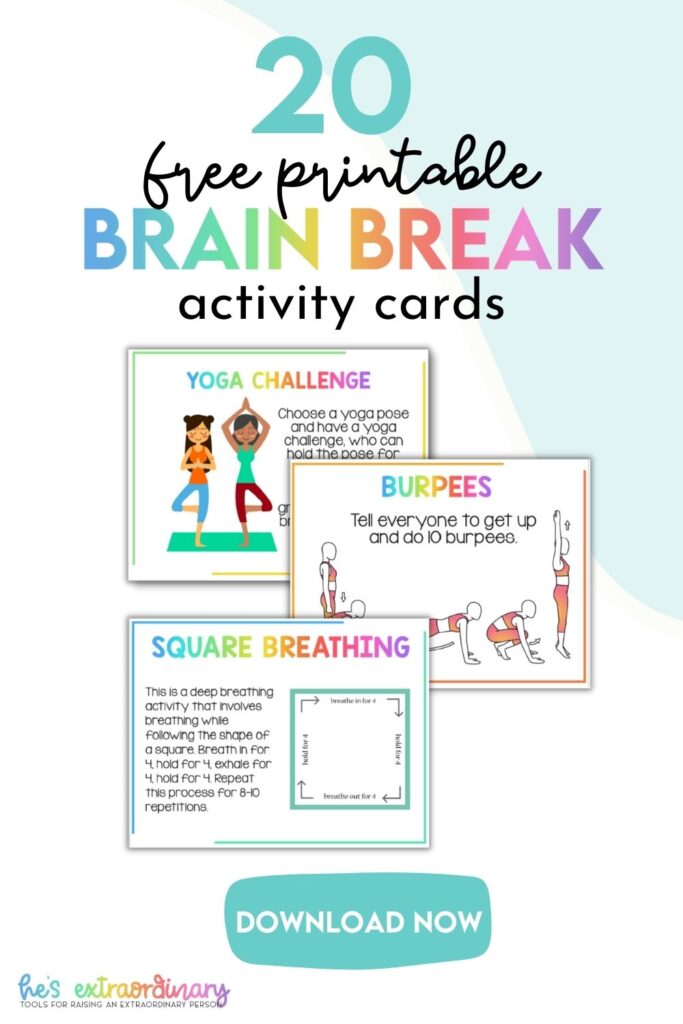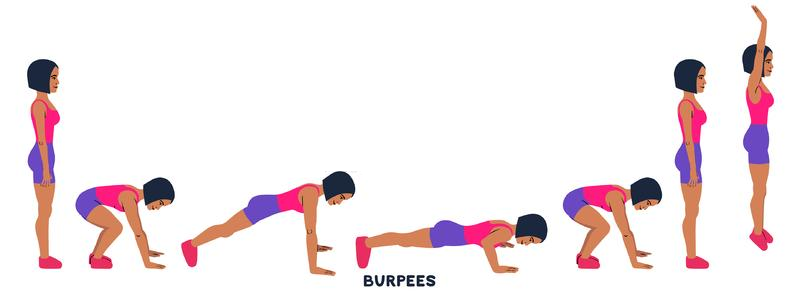Brain Breaks for Kids – 20 Printable Activity Cards
What’s inside this article: What brain breaks are and how they benefit kids, how and when to add them to kids’ daily routines, and instructions for 20 brain break activities. Free download of brain break activity cards at the bottom of this article.
Disclaimer: This post contains affiliate links.
Brain breaks are an effective way to increase focus, support self-regulation, and boost a child’s learning in the classroom (or home).
This article will answer some important questions about brain breaks for kids.
- What are brain breaks?
- How do brain breaks benefit children?
- How can you add brain breaks into your child/student’s day at optimal times?
Plus, I’ll list some fun brain break ideas for kids and at the end of the article, you’ll find a link to some free printable brain break cards.
What are Brain Breaks?
Let’s start with the basics.
Brain breaks are short (3 to 5 minute) mental breaks designed to help kids stay focused and attentive in the classroom or to help them through transition times.
They’re used during class time, homework time, or in between tasks.
Some optimal times for brain breaks would include just after lunch or recess, in between subjects in class, or at planned intervals during tasks where kids are expected to sustain focus on something for an extended period.
Benefits of Brain Breaks
Research shows brain breaks benefit kids in many different ways:
- supports emotional well-being and self-regulation
- improved focus and attention
- increases motivation in the classroom
- supports kinesthetic learning
- contributes to strong academic performance
Why Use Brain Breaks in the Class Room?
Brain breaks aren’t just a moment of play or rest during learning time, they help students reach their full potential.
There is science to back this up.
We know that the brain uses neurotransmitters to send messages across pathways. When doing the same task for a period of time, those transmitters begin to deplete. The brain needs time to produce more.
Shifting to a completely different activity engages a different region of the brain and different transmitters, and allows the now resting region of the brain to replenish its supply.
Research shows that these short breaks allow regions of the brain that are blocked by stress or high-intensity work to revitalize.
How Breaks Improve Learning
For new information to become stored in memory, it must reach the prefrontal cortex (responsible for executive functioning) by passing through the amygdala.
The amygdala controls the fight or flight instinct. In situations where we feel overwhelmed, anxious, upset, or confused, the amygdala blocks access to the prefrontal cortex, so no information gets in.
This is the reason why you can’t use reason when talking to a child mid-meltdown. And, it also impedes learning. Taking a brain break helps calm the brain, allowing the amygdala to relax, and restores the flow of important to the prefrontal cortex.
Incorporating Brain Breaks Into Children’s Routines
Research shows that when homes and classrooms have consistent routines and easy-to-understand structures, children behave better.
While brain breaks could be done spontaneously if you felt the class needed one – you should ideally schedule them into your day as part of your routine.
This way, you’re using them as a proactive strategy.
Best time of day to schedule Brain Breaks
For teachers:
- First thing in the morning
- Between subjects
- After recess
- After lunch
- After gym class
- Intermittently during times when kids need to sustain focus
- When a student is feeling frustrated and needs a short break
For Parents:
- During homework time
- Transition times when you need to bring energy levels down
- During unpreferred tasks – for example, while cleaning their bedroom
- Before bed – use a calming brain break
- In the morning – use an energizing brain break
Note: Parents, if your child struggles with focus and attention, or self-regulation, it might be beneficial to speak with their school about incorporating extra scheduled brain breaks into their school day.
Getting Started- How to Plan Brain Breaks
You’ll need just a little bit of pre-planning to get started with these brain breaks. All you need to do with these cards is download the free PDF and print it, then cut out the cards.
You could laminate these, and use a hole punch, then attach them to a key ring. This prevents the activity cards from getting lost or damaged. I’ve had a couple of teachers mention keeping the key ring of cards in their classroom calming corner, and that students tend to gravitate toward it when they go for breaks.
Make sure your kids know the purpose of the activity and how long it will take.
For younger children, using a timer helps them see how much time is passing so after you give the instructions, start the time. The timer provides a built-in warning that the break is winding down. You can also use verbal reminders.
Brain Break Activities

List of Brain Break Activities
Calming Brain Breaks
The brain needs time for processing and rest after learning.
Plus, to learn something new, the information needs to pass through the emotional filter in the brain (the amygdala) to reach the prefrontal cortex.
If kids are overwhelmed or anxious, that filter closes down and new information can’t be processed efficiently.
1. Square Breathing
This is a deep breathing activity that involves breathing while following the shape of a square. Breath in for 4, hold for 4, exhale for 4, hold for 4. Repeat this process for 8-10 repetitions.
You can also download the square breathing poster, along with 3 other deep breathing activities, here.
2. Spell Your Name with Your Breath
Take a deep breath in. Then, blow out slowly, while moving your head, to draw the letters of your name in the air with your breath.
This encourages kids to practice deep belly breathing in a fun way.
3. Blow Bubbles
Bubbles make a great calming brain break activity for kids.
Try to blow the biggest bubble you can, or blow smaller bubbles and try catching them on your fingers without popping them.
4. Body Scan
Students all close their eyes and the teacher/parent leads this activity.
Starting from the toes, direct kids to squeeze as tight as they can, and then release. Move up to the legs, buttocks, abdomen, hands, arms, neck, and face.
Finish by getting them to squeeze everything at the same time.
5. Listen Carefully
Set a timer for 1 minute. During the minute, everyone must sit with their eyes closed and stay completely quiet and listen for different sounds.
When the timer beeps, go around the room and take turns sharing what you heard.
6. Ring the Gong
You’ll need a desktop gong like this one to complete this brain break.
Everyone closes their eyes and sits quietly to listen. Ring the gong and wait. Everyone must listen carefully with their eyes closed. When you can no longer hear the gong – open your eyes.
7. Criss Cross Apple Sauce
This activity requires partners. Take turns reciting the rhyme while doing the actions on your partner’s back.
Criss-cross (draw an X with your fingers)
Apple Sauce (Gently tap your fingers down their back)
Spiders crawling up your arms (walk your fingers up their arms)
Light breeze (blow on the nape of your partner’s neck)
Tight Squeeze (hug or put pressure on their shoulders)
Now you’ve got the shiverys (light tickle back and forth along their back)
(This activity is my children’s favorite one and we do this together often.)
Active Brain Breaks
Active brain breaks are great for when the class is getting fidgety, or they’re expected to stay seated or focused for an extended period of time.
Active brain breaks stimulate the vestibular system. The vestibular system is located in our inner ear and it’s stimulated by movement. It helps our bodies stay alert.
After a period of inactivity, the vestibular nerve stops firing, making it harder to focus. A quick movement break gets it going again.
Children who are sensory seekers may need more intense or frequent movement breaks to get them through the day.
8. Reach for the Sky, Reach for your Toes
Stand up straight and reach your arms above your head, stretching as high as they can go. Then bend over and touch your lows, reaching as low as you can.
Repeat this movement/stretch 5 or 6 times.
Inverting the head, like when you bed over to touch your toes, is one of the best ways to stimulate the vestibular system.
9. Focus Ball
This is one of the many brain break activities found in Scholastic: Brain Breaks for the Classroom
PART ONE:
1. Stand with your feet and legs together.
2. Bring your fingertips together in front of your chest
3. Bend your finger joints to form a ball shape with your hands
4. Press your fingertips together firmly until you feel the muscles in your arms working.
4. See if you can hold that shape while you squeeze your legs together as tight as you can, too.
PART TWO:
1. Press your hands and your forearms together (starting with your fingertips and ending with your elbows) keeping your arms in front of your chest, with your fingers pointing forward.
2. Slowly “peel” apart your arms starting with your fingertips to your elbows.
3. Keep going, spreading your arms as wide as you can out to your sides.
4. As you open your arms, open your legs wide, too so you’re standing like a star.
10.Yoga Challenge
Choose a yoga pose and have a yoga challenge, who can hold the pose for the longest?
Tree pose is a great choice for this brain break activity.
If you want, you can download this poster of yoga poses for kids, and let the kids choose from the poster which poses they want to use for the yoga challenge.
11.Wall Push-Ups
Set your timer. Do push-ups against the wall until the time is up.
12. X marks the spot
Use tape to make an X on the floor for each child (or just use a sticker). Call out different body parts and have everyone touch that body part to their X.
Energizing Brain Breaks
These energy-boosting brain breaks can help regain your class’s attention if they’re bored and unfocused.
If your kids are overactive, using an activity like these to help exert their energy and then finishing off with some deep breathing or another calming option can help reset their brains and get them ready to learn.
13. Read it Do it
Read a book to the group, but every time you read a verb, have them act it out while standing in place.
14. Freeze Dance
Play some upbeat music and have everyone dance like crazy! But when you hit pause, they all need to freeze and hold their pose until the music starts again.
15. Burpees
Tell everyone to get up and do 10 burpees.

16. Miming
Get in partners and mime or mirror the actions of each other. There is no talking at all during this activity. After a minute or two, switch roles so both people get a chance to be the leader.
17. Inch Worms
Start in plank position. Jump your feet in towards your hands, so your body makes a “V” shape, then walk your hands forward until you’re back to the plank position.
Continue moving like this (go back and forth if there isn’t a lot of room) until the time is up.
18. Animal Walks
Direct your children to walk like different animals around the room.
Crab walk to the left
Bear walk to the right
Kangaroo hop forward
Elephant stomp backward
19. Shake Your Sillies Out
This is a fun action song from The Learning Station.
Either play the video or sing it yourself and get your kiddos to shake their sillies out.
20. Quick Workout Routine
Do each of these moves for 30 seconds each
Jumping jacks
Run in place
High knees
Scissor jumps
Download These Brain Breaks
You can download these brain breaks with their instructions to use as printable activity cards.
Laminate them and shuffle them in a pile and let your kids choose from the pile at random for surprise brain break activities.
Brain Breaks Activity Cards

